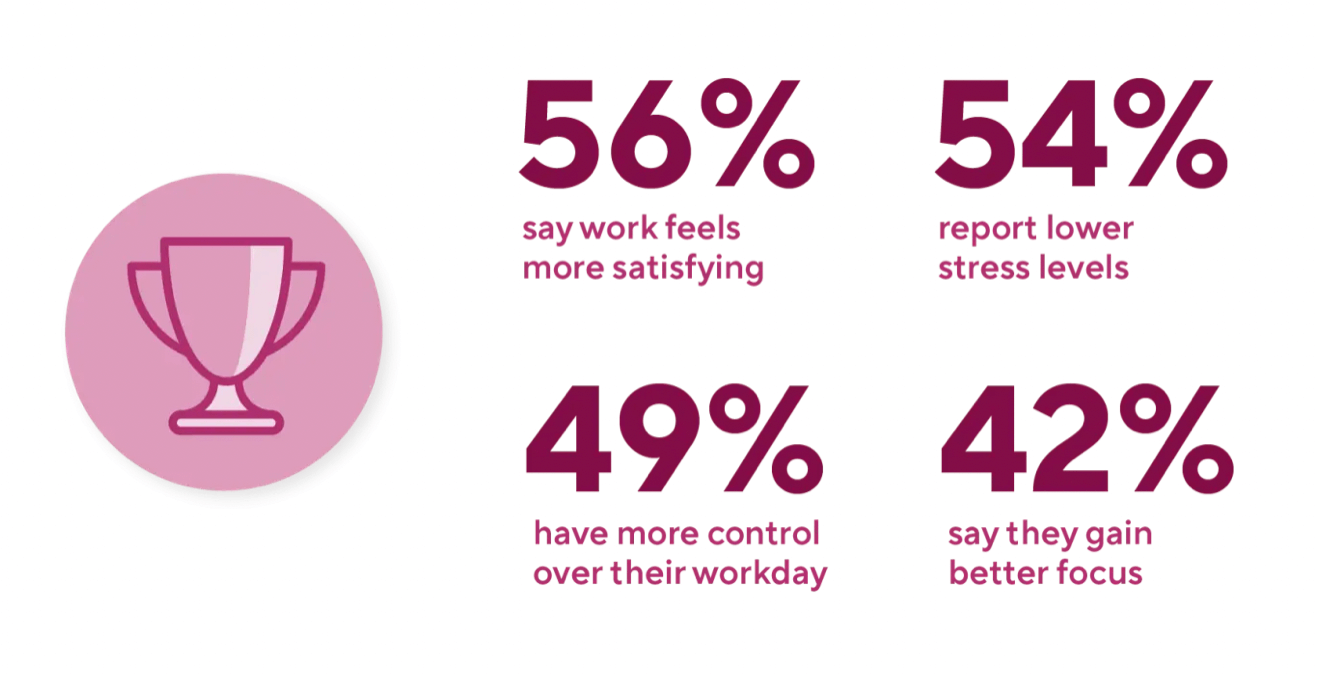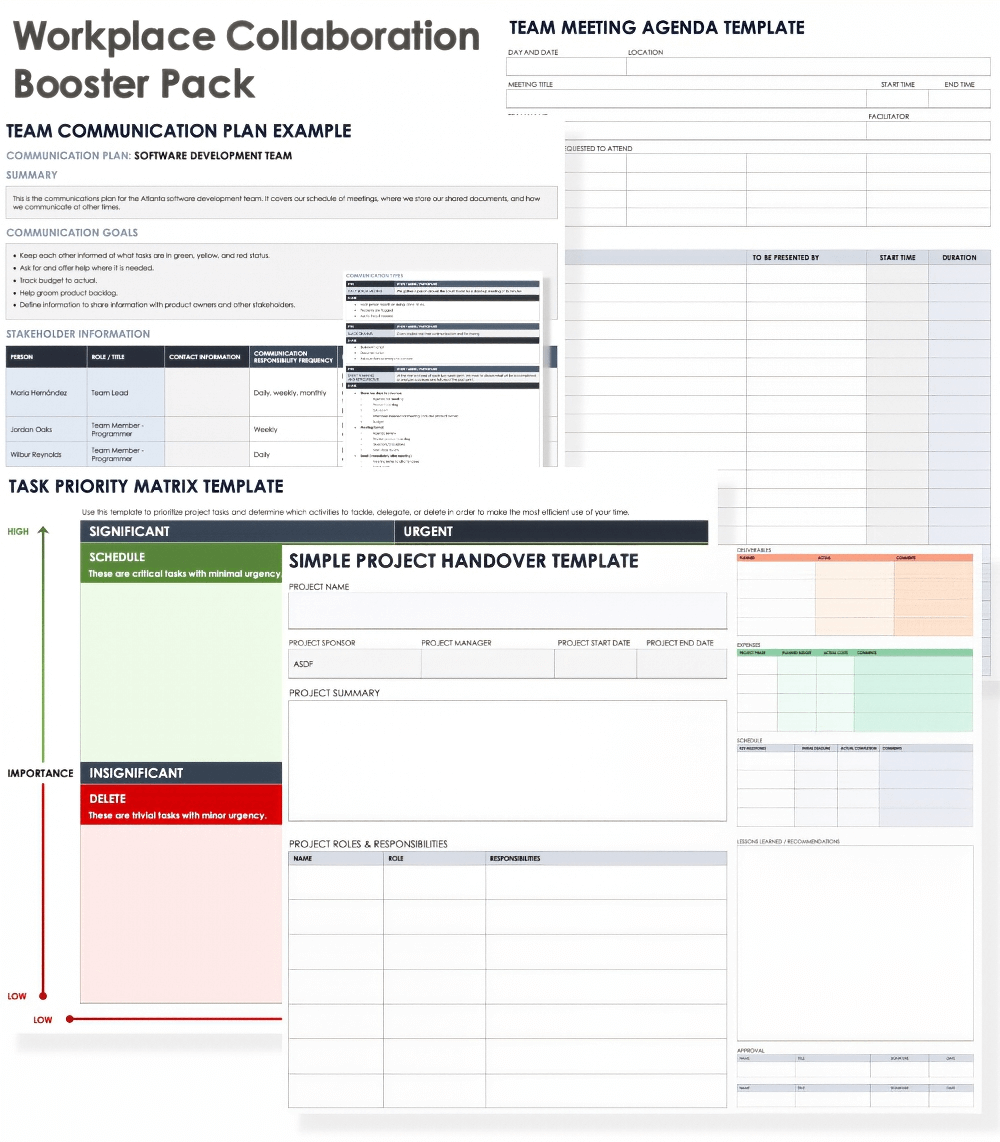How to Increase Workplace Collaboration
Increasing workplace collaboration is crucial for fostering a productive and engaged team. By embedding collaboration into the company culture, setting clear communication guidelines, and encouraging teamwork at every level, organizations can create an environment where employees thrive together.
Collaboration can help your team improve the quality of what’s known as middle work or, as described in the Smartsheet Future of Work Management Report 2023, “the work that happens day in and day out as teams work to complete a project, such as establishing reliable workflows, incrementally completing smaller tasks, and communicating well.”

The authors of the report also note the boost to employee morale that comes with improved collaboration: “when projects run smoothly (as opposed to simply being delivered on time), people notice that the work feels more satisfying (56%), that stress levels are lower (54%), and that they have more control over their workday (49%). Smoother-run projects also enable team members to gain better focus on their project contributions while at work (42%).”
The following are key strategies to enhance collaboration in your workplace. You can also learn more about how to improve team collaboration skills in this basic guide to teamwork and collaboration.
- Foster Collaboration as a Value: Establish collaboration as a core value in your company culture. Clearly communicate its importance and set specific goals that emphasize teamwork. When collaboration is prioritized, it becomes a natural part of daily operations.
- Establish Communication Standards and Encourage Open Communication: Develop clear guidelines for communication to ensure effective teamwork. Regular team meetings and open dialogue should be encouraged to create an environment where everyone feels comfortable expressing ideas. This openness supports innovation and ensures all voices are heard.
Jillian Knoepfel, Content Operations Manager at Smartsheet, highlights the importance of clear roles and open communication in fostering effective collaboration.
"Establishing clear roles and responsibilities ensures that each team member understands their role and how they fit into the greater team or organization,” she says. “By defining clear objectives and expectations upfront, we can avoid overlapping duties and ambiguity, which fosters a more collaborative environment. Encouraging open communication is also vital. We need to create an environment where team members feel comfortable sharing ideas, concerns, and feedback. Utilizing collaboration tools that allow real-time communication ensures that conversations flow in the context of the work being done." - Invite Co-Creation: Promote a culture of co-creation by organizing brainstorming sessions and discussions. Encourage team members to collaborate on ideas and projects, fostering a sense of shared ownership and creativity.
- Lead by Example: As a leader, demonstrate the collaborative behavior you wish to see in your team. Actively engage in teamwork, encourage participation, and show that collaboration is valued at all levels of the organization.
- Build Time for Team Bonding: Organize team-building activities that allow colleagues to strengthen their relationships outside of work tasks. These informal interactions help build trust and understanding, which are crucial for effective collaboration.
- Highlight Successful Teamwork: Recognize and celebrate instances of successful teamwork. Sharing these success stories not only motivates but also serves as a model for others, demonstrating the tangible benefits of collaboration.
- Offer Mentorship Opportunities: Provide mentorship programs that focus on developing collaboration skills. Mentorship can facilitate knowledge sharing and support professional growth, helping to build a more cohesive and capable team.
- Set Goals Collaboratively: Involve the entire team in the goal-setting process to ensure alignment and commitment. Collaborative goal-setting encourages innovation and ensures that everyone is working toward the same objectives.
Amelia Ransom, VP of Diversity, Equity, and Inclusion at Smartsheet, shares her thoughts on the importance of goal alignment and open-mindedness in successful collaboration.
"One of the things I think about when it comes to collaboration is that you should align at the beginning on what the goals are. What are we trying to accomplish?” she says. “If I'm collaborating with my colleague and our teams are working on a specific project, I like to align early.”
Ransom also stresses the importance of listening and remaining open to other perspectives. “Don’t write other people’s lines,” she says. “What I mean by that is, when you collaborate, don’t have an expectation of what the other person is thinking or how they might respond. You don’t write other people’s lines for them; you write your own lines and take accountability for yourself. You can influence other people, but you can’t change them, particularly when you’re collaborating." - Be Flexible: Adopt flexible strategies that accommodate the diverse needs of your team members. Recognize that different working styles exist, and support these differences to foster a more inclusive and collaborative environment.
- Use Shared Tools: Implement collaborative tools that centralize work and communication. Ensure that all team members have access to the same resources and updates, making it easier for them to work together efficiently and stay aligned on projects.
To learn more about selecting collaboration tools, check out this essential guide to collaborative work management software and this article on selecting the right online collaboration solution for your team.
Workplace Collaboration Booster Pack

Get multiple tools to enhance workplace collaboration with this free, downloadable booster pack. We've compiled a set of templates designed to support various strategies for increasing collaboration and improving project management. Start boosting team collaboration today by downloading the entire pack or selecting individual templates that meet your specific needs.
Included in this booster pack, you’ll find the following templates:
- A team communication plan example for PDF that includes space to write a summary, communication goals, stakeholder information, and communication types.
- A stakeholder management plan template for Excel that includes a spreadsheet for detailed analysis, as well as a matrix for mapping stakeholders.
- A simple project handover template for PDF and Word that includes all the components of a successful project handover.
- A task prioritization matrix template for Excel , Word , and PDF that enables you to prioritize project tasks and make the most efficient use of your time.
- A team meeting agenda template for Excel , Word , and PowerPoint that features space to record all meeting attendees and agenda items.
Strategies to Improve Team Collaboration
Improving team collaboration requires intentional strategies that promote communication, clarity, and connection among team members. By implementing certain tested strategies, you can create a more cohesive and productive team environment.
Here are some strategies to improve collaboration at any workplace:
- Promote Discussion: Encourage open dialogue and active listening within the team. Provide regular opportunities for feedback and idea sharing to ensure everyone’s voice is heard and valued.
Ransom stresses the importance of making sure every voice on the team is valued and heard. "If I’m the project lead, I make sure to spend time with the group, but I also schedule one-on-one meetings for anything that might not get covered in the group setting,” she says. “Some people need time to reflect before expressing their opinion, and I want to make sure I don’t miss anything they’re thinking about.”
This approach has helped her in the past. “I remember a person on my team who was definitely the reflective type,” she recalls. “She didn’t say much in meetings, but she was a deep thinker. If you only listened to her in meetings, you might think she didn’t have much to offer. But in reality, she had a lot to contribute. Some questions I like to ask are, 'What’s something that’s going well in the group that’s helping you participate or helping us reach our goals? What’s something that’s not useful or helpful that we need to stop doing?'" - Stay Organized: Implement systems to keep track of tasks, responsibilities, and progress. Staying organized helps the team remain on course and meet deadlines efficiently.
- Schedule Team-Building Activities: Incorporate short, engaging activities into your schedule to foster team bonding. These activities help improve communication and strengthen teamwork by allowing members to connect on a more personal level.
“Regular team meetings and team-building activities are essential, whether they are remote exercises or in-person gatherings, as they help build trust and rapport among team members,” says Knoepfel. “Celebrating successes together further enhances the sense of shared achievement and camaraderie." - Assign Roles: Designate roles based on individual strengths and the needs of the collaboration. Providing mentorship roles can also help newer team members integrate and grow within the team.
Knoepfel highlights the benefits of assigning roles that extend beyond primary responsibilities, combined with team-building activities. "Allowing team members to work on projects outside of their primary roles fosters a better understanding of each other’s contributions and how all the pieces connect,” she says. “This approach builds a more cohesive and collaborative team.” - Establish Goals: Set clear, shared objectives for the team to work toward. Regularly review and adjust these goals to maintain focus and ensure that everyone remains motivated.
“I was working on something recently, and I said, 'OK, our key tenets are: What is the business need, and what is the employee experience?' Those are the two things that should govern every decision we make along the way,” explains Ransom. “Every time we needed to, we went around and checked our two tenets: business need and employee experience. Every single time, it helped us make the right decision. What happens when you do that is that you take people and egos out of it. The key is to establish what the goal is before we do any work. No work gets done before we do that. And then we constantly come back to it. Are we living up to that?" - Set Expectations: Clearly communicate performance and collaboration standards to the team. Align these expectations across different teams and departments to ensure consistency and clarity.
- Socialize Outside the Workplace: Organize social events to build stronger interpersonal connections among team members. If in-person gatherings aren't possible, encourage virtual meetups to maintain team bonds.
- Brainstorm Together: Allocate dedicated time for collaborative brainstorming sessions. These sessions can help generate new ideas and solutions by tapping into the collective creativity of the team.
- Compose a Project Mission Statement: Create a shared mission statement that unifies the team’s efforts and goals. Use this statement to motivate and guide the team throughout the project, ensuring everyone is aligned and working toward the same objectives.
Tactics for Enhancing Cross-Team Collaboration
Enhancing cross-team collaboration is vital for creating a unified and efficient organization. By adopting tactics to foster strong relationships between different departments and ensuring clear communication, companies can break down silos and promote a more collaborative work environment.
Here are some key tactics to enhance cross-team collaboration and drive overall team success.
- Executive Support: Ensure top executives actively invest in building social relationships and promoting collaborative practices across teams. Their commitment sets the tone for a culture of collaboration throughout the organization.
- Focused HR Practices: Implement HR initiatives that develop collaboration skills across the organization. Foster a sense of community through sponsored events and activities that bring employees together from different departments.
- The Right Team Leaders: Assign leaders who can effectively balance task-oriented and relationship-oriented management. These leaders should be adept at fostering collaboration across teams while keeping the focus on achieving shared goals.
- Team Formation and Structure: Build teams that leverage preexisting relationships to enhance trust and collaboration. Clearly define roles and responsibilities within these teams to promote effective and efficient teamwork.
Amanda Reineke, CEO and Co-Founder of NOTICENINJA, shares how strategic team pairing can lead to significant improvements in business processes.
"As CEO, I meet with teams to understand their challenges and then connect groups with complementary strengths. For example, I paired our customer success team with our research and development team to improve the client onboarding process. Through their collaboration, they created an online knowledge base that reduced client onboarding calls by 30 percent in the first quarter." - Promote Discussion Across Teams: Facilitate dialogue between different teams to share ideas and feedback. Encourage active listening and participation across departments to ensure that all perspectives are considered.
"Creating clear communication channels and using collaborative tools to keep communications centralized ensures that team members stay informed and aligned,” says Knoepfel. “A dashboard for real-time project updates and reports can make cross-functional meetings more productive by focusing on challenges, opportunities, and next steps." - Stay Organized Across Teams: Use shared tools and systems to keep multiple teams aligned and coordinated. Regular cross-team meetings help maintain focus and ensure that everyone is working toward common objectives.
For example, Ransom highlights the importance of considering time zones when organizing team meetings. While it may seem trivial, accommodating different time zones is crucial for effective team collaboration.
"It might seem like a small thing, but you wouldn't believe how many meetings overlook this,” she says. “Are you telling me that someone in the U.K. is getting up at three o'clock in the morning every time you have a meeting? That’s wild. Time zones are a reality we need to work with, and sometimes that means adjusting our own schedules. People don't realize how much of a difference this consideration makes." - Assign Cross-Team Roles: Designate roles that bridge different teams, facilitating collaboration and ensuring that responsibilities are clearly defined across departments.
- Establish Cross-Team Goals: Set shared objectives that require collaboration between teams. Regularly review progress and adjust strategies as needed to keep all teams aligned and focused on achieving these goals.
"Aligning on common goals and objectives is crucial,” explains Knoepfel. “Ensuring all teams understand the overarching goals and how their work contributes to achieving them helps maintain focus. Developing a project plan with clear milestones, timelines, and deliverables, along with the right access levels, encourages transparency and open dialogue early on to address any misalignments or conflicting priorities." - Socialize Across Teams: Organize events that bring together employees from different teams. These social opportunities help build interteam relationships and foster a stronger sense of community across the organization.
A simple tool can go a long way in fostering real-time communication and building stronger team connections, Ransom explains. "A shared channel where people can comment in real time, but on their own schedule, is incredibly valuable,” she says. “Collaborative documents, workspaces, or any tool that supports real-time communication is really useful. These tools help people connect on a personal level, leading to stronger working relationships. For example, if someone knows I like hiking and mentions a great trail, the next time I message them with a work question, they're more likely to respond quickly because of that personal connection. It’s these kinds of small interactions that make a big difference in how teams collaborate."
Review this guide to collaborative working, or this overview of document collaboration, for additional guidance and tips.
Find the Best Tool for Team Collaboration with Smartsheet for Work Management
Empower your people to go above and beyond with a flexible platform designed to match the needs of your team — and adapt as those needs change.
The Smartsheet platform makes it easy to plan, capture, manage, and report on work from anywhere, helping your team be more effective and get more done. Report on key metrics and get real-time visibility into work as it happens with roll-up reports, dashboards, and automated workflows built to keep your team connected and informed.
When teams have clarity into the work getting done, there’s no telling how much more they can accomplish in the same amount of time. Try Smartsheet for free, today.


